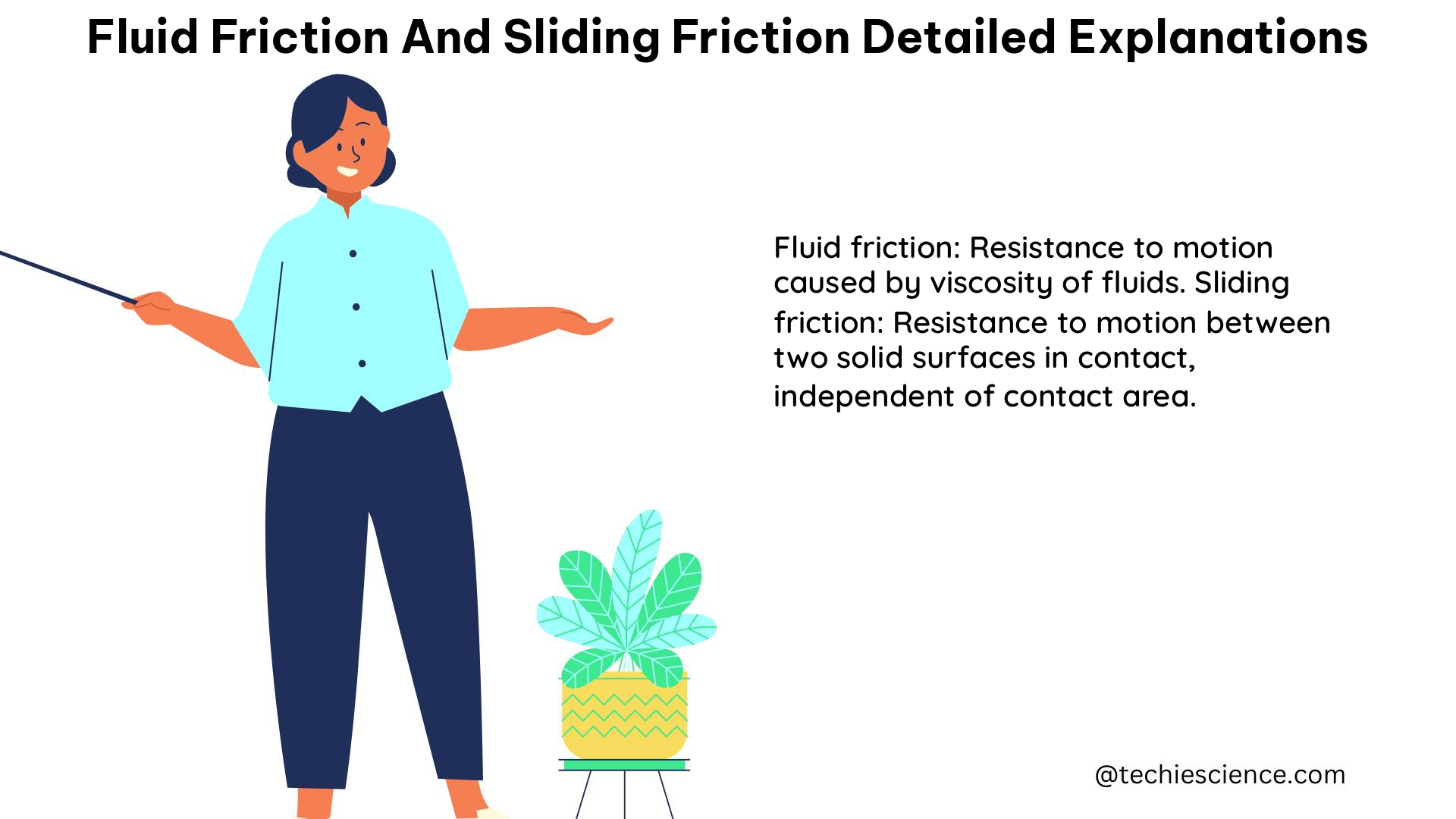Fluid friction, also known as viscous drag, is the frictional force exerted by fluids, while sliding friction is the resistance created between any two objects when they are sliding against each other. This comprehensive guide delves into the intricate details of these two types of friction, providing a thorough understanding for physics students.
Understanding Fluid Friction
Fluid friction, or viscous drag, is the force that arises due to the internal friction between layers of fluid that are moving relative to each other. This friction is caused by the intermolecular forces between the particles within the fluid, which is known as viscosity.
Viscosity and Its Measurement
Viscosity is a measure of a fluid’s resistance to flow. Fluids with high viscosity, such as honey or syrup, have a higher resistance to flow and experience more fluid friction. Conversely, fluids with low viscosity, like water or fruit juice, have a lower resistance to flow and experience less fluid friction.
The viscosity of a fluid can be measured in various units, including poise and pascal-seconds (Pa·s). For example, the viscosity of water at room temperature is approximately 1 centipoise (cP), while the viscosity of honey is around 10,000 cP.
Factors Affecting Fluid Friction
The amount of fluid friction experienced by an object depends on several factors:
- Fluid Viscosity: As mentioned earlier, the higher the viscosity of the fluid, the greater the fluid friction.
- Relative Velocity: The faster the object moves through the fluid, the greater the fluid friction.
- Surface Area: The larger the surface area of the object in contact with the fluid, the greater the fluid friction.
- Fluid Density: The higher the density of the fluid, the greater the fluid friction.
Calculating Fluid Friction
The fluid friction force (F) experienced by an object moving through a fluid can be calculated using the following formula:
F = 6πηrv
Where:
– η (eta) is the dynamic viscosity of the fluid (in Pa·s or N·s/m²)
– r is the radius of the object (in meters)
– v is the relative velocity between the object and the fluid (in m/s)
This formula is known as Stokes’ law and is applicable for objects moving at low Reynolds numbers (Re < 1), where the flow is laminar.
Reynolds Number and Fluid Flow Regimes
The Reynolds number (Re) is a dimensionless parameter that is used to determine the flow regime of a fluid (laminar or turbulent). It is calculated using the formula:
Re = ρvd/μ
Where:
– ρ (rho) is the density of the fluid (in kg/m³)
– v is the velocity of the object (in m/s)
– d is the diameter of the object (in meters)
– μ (mu) is the dynamic viscosity of the fluid (in Pa·s or N·s/m²)
When the Reynolds number is low (Re < 2300), the flow is considered laminar, and Stokes’ law can be used to calculate the fluid friction. When the Reynolds number is high (Re > 4000), the flow becomes turbulent, and the fluid friction can be calculated using different formulas.
Understanding Sliding Friction

Sliding friction, on the other hand, is the resistance that is created between any two objects when they are sliding against each other. This friction is caused by the interactions between the molecules of the solid surfaces and the molecules of the fluid (such as air or lubricant) between them.
Coefficient of Sliding Friction
The force of sliding friction (F) is defined as the product of the coefficient of sliding friction (μ) and the normal force (N) acting on the surfaces:
F = μ × N
The coefficient of sliding friction is a dimensionless quantity that depends on the materials in contact and the conditions of the contact. It typically ranges from 0 to 1, with higher values indicating greater friction.
Factors Affecting Sliding Friction
The coefficient of sliding friction can be influenced by several factors:
- Surface Roughness: Rougher surfaces generally have higher coefficients of sliding friction.
- Lubrication: The presence of a lubricant between the surfaces can significantly reduce the coefficient of sliding friction.
- Temperature: Increased temperature can affect the coefficient of sliding friction, either increasing or decreasing it, depending on the materials involved.
- Humidity: The presence of moisture can also influence the coefficient of sliding friction.
Measuring Sliding Friction
The coefficient of sliding friction can be measured experimentally using various methods, such as the inclined plane method or the block-on-plane method. Typical values for the coefficient of sliding friction include:
- Dry steel on dry steel: ~0.5
- Wet glass on wet glass: ~0.04
- Teflon on Teflon: ~0.04
Applications of Sliding Friction
Sliding friction plays a crucial role in various engineering applications, such as:
- Braking Systems: Sliding friction is the primary mechanism behind the braking of vehicles, where the brake pads apply a normal force to the rotating brake discs or drums, causing them to slow down or stop.
- Traction and Locomotion: Sliding friction between the tires and the road surface is essential for the traction and movement of vehicles, as well as for the locomotion of various animals and machines.
- Mechanical Joints and Bearings: Sliding friction is a consideration in the design and operation of mechanical joints and bearings, where it can affect the efficiency and wear of the components.
By understanding the detailed explanations of fluid friction and sliding friction, physics students can gain a comprehensive knowledge of these fundamental concepts and their applications in various fields of study and engineering.
Reference:
- Fluid Friction | Definition, Types & Example – Lesson – Study.com
- Viscosity is, essentially, liquid friction – Galileo
- Fluid Friction And Sliding Friction: Detailed Explanations – YouTube
- Types Of Friction – Static, Sliding, Rolling And Fluid Friction – BYJU’S
- A simple measurement of the sliding friction coefficient – ResearchGate

I am Deepak Kumar Jani, Pursuing PhD in Mechanical- Renewable energy. I have five years of teaching and two-year research experience. My subject area of interest are thermal engineering, automobile engineering, Mechanical measurement, Engineering Drawing, Fluid mechanics etc. I have filed a patent on “Hybridization of green energy for power production”. I have published 17 research papers and two books.
I am glad to be part of Lambdageeks and would like to present some of my expertise in a simplistic way with the readers.
Apart from academics and research, I like wandering in nature, capturing nature and creating awareness about nature among people.
Also refer my You-tube Channel regarding “Invitation from Nature”